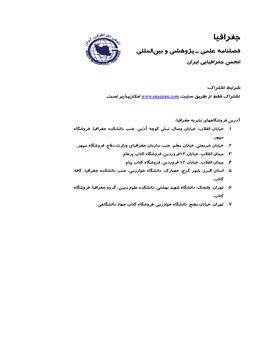Integrating the climatic data and remote sensing for detection of Oak drought condition (Case study: Ilam province)
Subject Areas :1 , 2 , zohreh shahghasemi 3
1 -
2 -
3 -
Keywords: MODIS, droughts, Oak, Ilam,
Abstract :
In terms of oxygen production, reduction of pollution and environment diversity forest is one of the most important among other resources and is considered as an important resource for the survival of the human and is a safe environment for wildlife. Climate and its parameters have a fundamental role in the formation and life of forest. There are various types of forest. Oak western forest is the second largest areas of forest in Iran. In recent years, this forest has been suffering from dieback phenomenon. The main aim of this study is to monitor forest dieback in Ilam Province. For this purpose, synoptic station data and remote sensing data were used for the study of climate and the process of dieback, respectively. It was tried to be used a period of long-term data and good distribution of stations. The results showed that the forest dieback phenomenon in Ilam Province mostly is due to the reduction trend of precipitation. The most severe droughts condition was occurred in 2008 and 2005. As a result of these changes, the growth of forest trees over the same priod has been greatly altered. Time trend analysis of trees greenness showed that in 2008 and afterward the amount of trees greenness significantly was reduced. This situation represents a direct relation between climate parameters temperature with the greenness of trees in the region.
1. باعقیده، م.، علیجانی، ب.، ضیائیان، پ.، (1390)، بررسی امکان استفاده از شاخص پوشش گیاهی NDVI در تحلیل خشکسالی¬های استان اصفهان، مطالعات جغرافیایی مناطق خشک، 1 (4): 16-1.
2. بی¬نام، 1393. آمار و اطلاعات سازمان هواشناسی کشور؛
3. بي نام. (1391)، دستورالعمل مديريت پايدار جنگل در اكوسيستم¬هاي جنگلي زاگرس به¬منظور پيشگيري و كنترل خشكيدگي بلوط، سازمان جنگل¬ها و مراتع و آبخيزداري، معاونت مناطق مرطوب و نيمه مرطوب، تهران، 60 صفحه؛
4. جزیره¬ای، م. ح، ابراهیمی رستاقی، م. (1382)، جنگل¬شناسی زاگرس. انتشارات دانشگاه تهران؛
5. ذاکری انارکی، س.، فلاح شمسی، س.ر. (۱۳۹۲)، تهیه نقشه سیمای طبیعی سرزمین با استفاده از تحلیل بافت تصویر سنجنده Rapideye، نخستین کنفرانس بینالمللی اکولوژی سیمای سرزمین،دانشگاه اصفهان؛
6. رضیئی،ط.، فتاحی،ا.(1390)، ارزیابی کاربرد دادههای بارش NCEP/NCARدر پایش خشکسالی ایران،مجله فیزیک زمین وفضا، 37 (2): 247-225؛
7. زهره¬وندی، ع.ا.، ثاقب طالبی، خ.، پوررضا، م.، خان حسینی، م.، خداکرمی، ی. (1390)، بررسی نیاز رویشگاهی گونه بلوط ایرانی در جنگل¬های استان کرمانشاه، فصلنامه علمی پژوهشی اکوسیستم¬های طبیعی ایران، 2 (2): 63-53؛
8. سنجری، ص.، برومند، ن. (1392)، پایش تغییرات کاربری/پوشش اراضی در سه دهه گذشته با استفاده از تکنیک سنجش از دور (مطالعه موردی: منطقه زرند استان کرمان) ، کاربرد سنجش از دور و GIS در علوم منابع طبیعی، 4(1): 57-67؛
9. فتاحي، م. (1373)، بررسي جنگل¬هاي بلوط زاگرس و مهم ترين عوامل تخريب آن، موسسه تحقيقات جنگل¬ها و مراتع كشور، نشریه شماره 101، 63 صفحه؛
10. معصومی،ع.،کافی،م.،نباتی،ج.،خزاعی،ح.ر.،داوری،ک.،زارع،م. (1391)، اثر تنش خشکی بر وضعیت آبی و نشت الکترولیت برگ، فتوسنتز و فلورسانس کلروفیل درمراحل مختلف رشد، نشریه پژوهش های زراعی ایران،شماره 3،صص 484-476؛
11. مهدوی، ع.، میرزایی زاده، و.، نیک¬نژاد، .م، کرمی، ا. (1394)، بررسی و پیشبینی زوال درختان بلوط با استفاده از مدل رگرسیون لجستیک (مطالعه موردی: جنگلهای بیوره ملکشاهی- ایلام)، دوفصلنامه تحقیقات حمایت و حفاظت جنگلها و مراتع ایران، 13 (1): 33-20.
12. مهدی عرفانیان، م.، وفایی، ن.، رضائیان زاده، م. (1393)، ارائۀ یک روش نوین برای ارزیابی ریسک خشکسالی استان فارس با تلفیق داده¬های ماهانۀ بارندگی ماهوارۀ TRMM و داده¬های شاخص پوشش گیاهی NDVI سنجندۀ Terra/MODIS، پژوهش¬های جغرافیای طبیعی، 46 (1): 108-93؛
13. Bhuiyan, C., Singh, R.P., and Kogan, F.N. (2006), Monitoring drought dynamics in the Aravalli Region (India) using different indices based on ground and remote sensing data. Inter. J. Appl. Earth Obs. Geoinf. 8: 289-30;
14. Cai, X.L., Sharma, B.R., Integrating remote sensing, census and weather data for an assessment of rice yield, water consumption and water productivity in the Indo-Gangetic river basin. Agricultural Water Management 97: 309–316;
15. Coombs, A.J. (1999), Trees. Dorlins kindersly Book, London. 128 p;
16. Klisch, A.; Atzberger, C. (2016), Operational Drought Monitoring in Kenya Using MODIS NDVI Time Series. Remote Sens. 8 ( 267): 1-22;
17. Liu, W. T., and R. I. N. Juarez.(2001), ENSO drought onset prediction in northeast Brazil using NDVI, Int. J. Remote Sens., 22, 3483 – 3501;
18. Olsson P.-O., Kantola T., Lyytikäinen-Saarenmaa P., Jönsson A. M., Eklundh L. (2016), Development of a method for monitoring of insect induced forest defoliation – limitation of MODIS data in Fennoscandian forest landscapes. Silva Fennica 50 (2): 1-22;
19. Thenkabail, P. S., Gamage, M. S. D. N., Smakhtin, V. U. (2004), The use of remote sensing data for drought assessment and monitoring in Southwest Asia, Research Report 85, International water management Institute;
20. Wang, J., Price, K.P., Rich, P.M., Spatial patterns of NDVI in response to precipitation and temperature in the central Great Plains. int. j. remote sensing 22 (18): 3827–3844;


